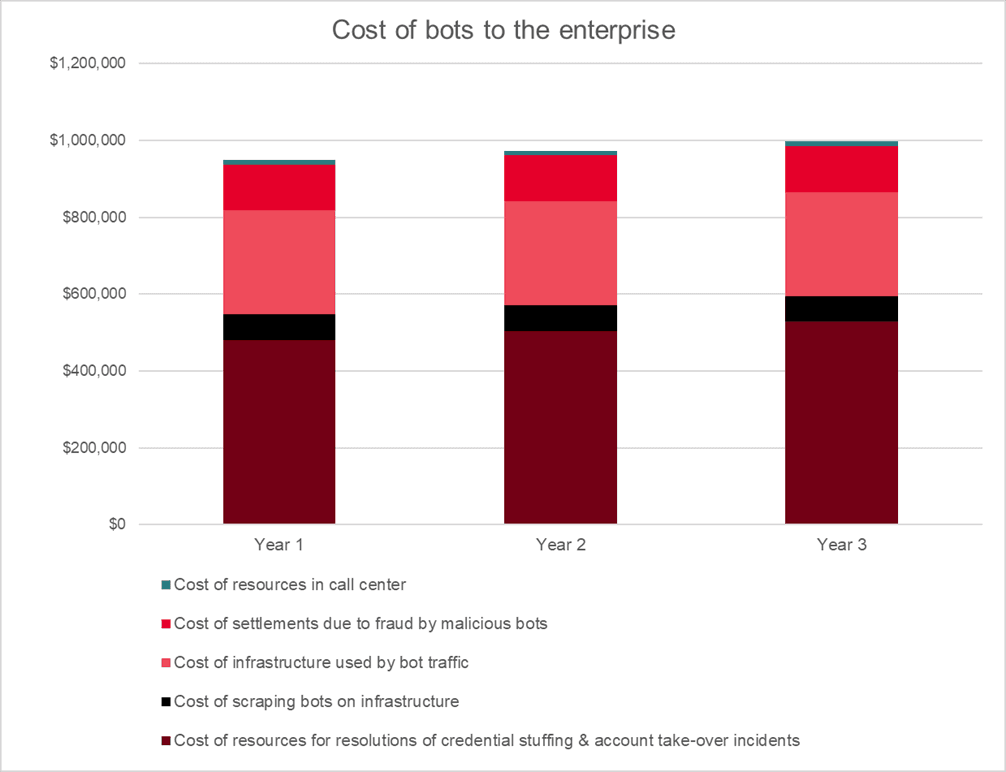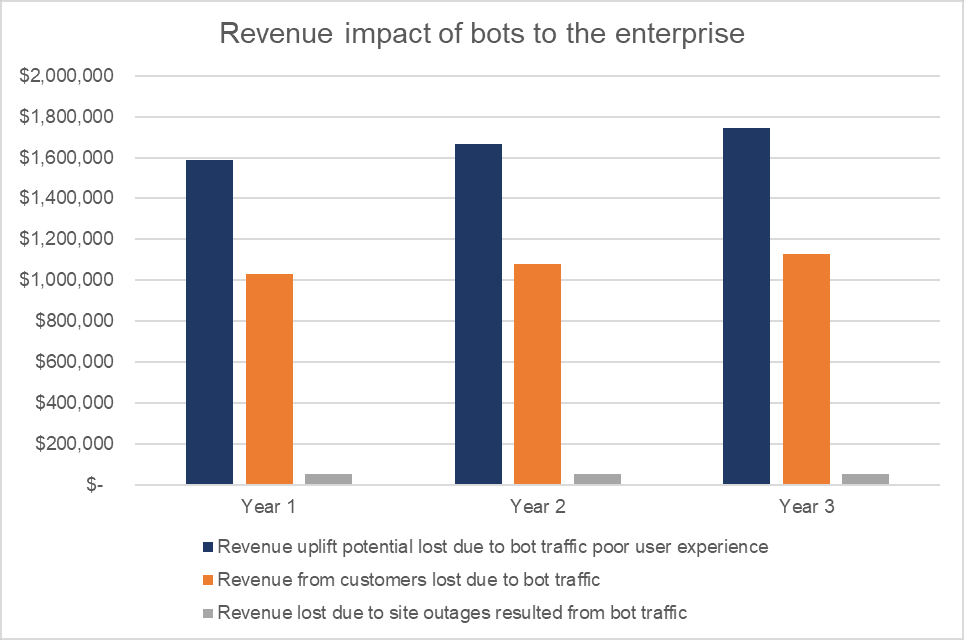While digital transformation efforts continue to accelerate, industries face a major challenge: ensuring application security against malicious bots to minimize business impact. Marshalling the resources to achieve this requires explaining the quantitative and qualitative impacts bots have on your business to your board and C-suite.
As a business stakeholder, you know malicious bot attacks are more than a threat to your security infrastructure—they represent a business challenge that must be addressed to preserve your organization’s operations and fiscal viability. Bots jeopardize your customer experience initiatives, risking revenue loss, increasing the cost of gaining new customers, and causing you to miss out on opportunities to upsell products and services. And, according the Forrester Total Economic Impact Report, operational teams can waste up to 10,000 hours on manual bot protection.
Indeed, the damages caused by malicious bots are so varied that it can even be a challenge to explain the extensive costs to your organization’s business leaders if they’re not familiar with the threat landscape.
Moreover, every organization is unique. While generic market research may explain the impact of bot attacks and the business benefits of bot mitigation, such research may not reflect the distinct realities of your business. How can you communicate the economic impact of malicious bots in a way that reflects your own business case?
To accomplish this, let’s review a concrete instance of an organization that went through the effort to create such a business case and see what they learned.
Bot Mitigation Case Study
To illustrate the financial value of successful bot management, consider the following real-world example based on a consultation performed by F5 for a major retailer with both in-store and online shopping sites. With more than 30 million user accounts and an average monthly revenue per user account of about $50, the threat of malicious bots for this retailer was hardly a trivial business issue.
Malicious bot activity had led to increased expenditures of time, effort, and resources from their IT and operations teams. Bot exploits included credential stuffing and account takeover (ATO) incidents that had to be resolved, requiring the effort of skilled IT security staff and customer-facing call centers. In addition, some of these incidents required refunds or credits, adding settlement costs to operational expenses.
Infrastructure costs due to bots were also hurting the business. Even though the company’s infrastructure had ample capacity for its revenue-generating traffic, there was no way to stop the free flow of malicious bots through the infrastructure, which exhausted web-hosting resources from the company’s third-party cloud provider. Scraping bots—bots that crawled the site constantly to extract competitive data—caused site outages and impacted the end-user experience, leading to lost customers, lost revenue, and lost opportunities to upsell. (In a separate example, VegNonVeg experienced similar added costs and negative outcomes due to scrapers.)
The retailer worked with F5 through a cost/benefit modeling exercise to calculate the following:
Cost savings: Approximately $1 million each year in operational costs savings by more effectively mitigating bots.

Revenue impact: With improved bot management, the retailer could save nearly $50,000 in revenue loss prevention per year due to fewer site outages, and about $1 million in revenue loss prevented annually from a decrease in lost user accounts and customer churn attributable to poor user experience.

Also, additional $1.6 million revenue uplift through improved conversion rates, resulting from frictionless user experiences and customers staying on the site longer.
Total benefit: Approximately $11 million total economic benefit could be gained over three years through improved bot management.
So, how can you benefit from cost benefit modeling?
To better assist customers in developing a cost/benefit analysis for bot mitigation, F5 has developed a web-based modeling tool that takes a broad range of inputs and produces a business case in a language that will allow you to better explain to business leaders how improved bot management strategies can help recession-proof the business.
Examples of costs and revenue data insights include:
- Resolutions of account takeovers caused by credential stuffing
- Incident reporting in call centers
- Infrastructure costs caused by automated traffic
- Revenue lost due to site outages
- Revenue impact from poor brand and customer experiences
Sign Up for a Free Bot Business Impact Consultation
Find out how much malicious bots are costing your business in fraud, infrastructure expenses, employee burnout, and lost customers by signing up for a free and comprehensive bot business impact analysis customized to your business and industry. Or use the free bot impact calculator today for a high-level view of the business impact of bots on your organization.
In addition, to learn how to better communicate the costs that automated bot attacks inflict on your organization and the business benefits of successful bot management, read the white paper From Bots to Boardroom: How Bad Bots Negatively Impact Your Balance Sheet.
About the Author
Related Blog Posts

AppViewX + F5: Automating and orchestrating app delivery
As an F5 ADSP Select partner, AppViewX works with F5 to deliver a centralized orchestration solution to manage app services across distributed environments.

Build a quantum-safe backbone for AI with F5 and NetApp
By deploying F5 and NetApp solutions, enterprises can meet the demands of AI workloads, while preparing for a quantum future.

F5 ADSP Partner Program streamlines adoption of F5 platform
The new F5 ADSP Partner Program creates a dynamic ecosystem that drives growth and success for our partners and customers.
F5 NGINX Gateway Fabric is a certified solution for Red Hat OpenShift
F5 collaborates with Red Hat to deliver a solution that combines the high-performance app delivery of F5 NGINX with Red Hat OpenShift’s enterprise Kubernetes capabilities.
F5 Silverline Mitigates Record-Breaking DDoS Attacks
Malicious attacks are increasing in scale and complexity, threatening to overwhelm and breach the internal resources of businesses globally. Often, these attacks combine high-volume traffic with stealthy, low-and-slow, application-targeted attack techniques, powered by either automated botnets or human-driven tools.
Phishing Attacks Soar 220% During COVID-19 Peak as Cybercriminal Opportunism Intensifies
David Warburton, author of the F5 Labs 2020 Phishing and Fraud Report, describes how fraudsters are adapting to the pandemic and maps out the trends ahead in this video, with summary comments.